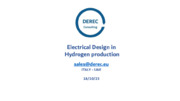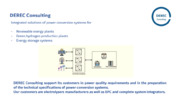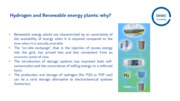Articolo
Electrical Design in Hydrogen production
(in lingua inglese)
- Hydrogen and Renewable energy plants: why?
- Green Hydrogen and Electrical Design
- Power Quality Requirements (THD, PF, DC Ripple)
- Hydrogen Production Electrolysis Technologies
- DC Power Supply technologies
- Electrolysers and Renewable Energy Plants
- PV plant and hydrogen production "off grid"; "DC/DC connection" Hydrogen and Renewable energy plants: why?
- Renewable energy plants are characterized by an uncertainty of the availability of energy when it is required compared to the time when it is actually available
- The "on-site exchange", that is the injection of excess energy into the grid, has proved less and less convenient from an economic point of view
- The introduction of storage systems has improved both self-consumption and the convenience of selling energy on a deferred basis.
- The production and storage of hydrogen (for P2G or P2P use) can be a valid storage alternative to electrochemical systems (batteries).
Green Hydrogen and Electrical Design
Green Hydrogen is produced by electrolysis of water that require a DC power supply.
There are different solutions for the selection of the right power supply design based on required performances and integration with the grid and renewable energy plants upstream.
Battery storage are often coupled with electrolysers to improve the stability and continuity of the renewable energy plant. DC Disconnectors are mandatory for safety and maintenance purposes
Power Quality Requirements (THD, PF, DC Ripple)
Electrolyser's stacks require DC voltage with a small ripple (usually lower than 5%) to assure the best performances such as operating life and efficiency.
High Power factor is an important requirements because it is mandatory when connected to the grid (usually higher than 0.95) and because allow to have the strict min required size of transformers (kVA). Harmonics generated by the converter (measured with THD or TDD) must be limited to avoid instability upstream on the grid.
Hydrogen Production Electrolysis Technologies
- Alkaline Water Electrolysis (AWE)
- Alkaline Water with Anion Exchange Membrane Electrolysis (AEM)
- Proton Exchange Membrane Electrolysis (PEM)
- Solid Oxide Electrolyser Cell (SOEC)
The selection of electrolysys technology is the result of the evaluation of quantity and quality of H2 produced, type of energy and water available, efficiency and CAPEX/OPEX. Each technology has got its own characteristics to match with a certain power conversion technology. DEREC Consulting is your ideal partner to define hydrogen production system specification.
Attached, you can download the full pdf of the presentation.
- Hydrogen and Renewable energy plants: why?
- Green Hydrogen and Electrical Design
- Power Quality Requirements (THD, PF, DC Ripple)
- Hydrogen Production Electrolysis Technologies
- DC Power Supply technologies
- Electrolysers and Renewable Energy Plants
- PV plant and hydrogen production "off grid"; "DC/DC connection" Hydrogen and Renewable energy plants: why?
- Renewable energy plants are characterized by an uncertainty of the availability of energy when it is required compared to the time when it is actually available
- The "on-site exchange", that is the injection of excess energy into the grid, has proved less and less convenient from an economic point of view
- The introduction of storage systems has improved both self-consumption and the convenience of selling energy on a deferred basis.
- The production and storage of hydrogen (for P2G or P2P use) can be a valid storage alternative to electrochemical systems (batteries).
Green Hydrogen and Electrical Design
Green Hydrogen is produced by electrolysis of water that require a DC power supply.
There are different solutions for the selection of the right power supply design based on required performances and integration with the grid and renewable energy plants upstream.
Battery storage are often coupled with electrolysers to improve the stability and continuity of the renewable energy plant. DC Disconnectors are mandatory for safety and maintenance purposes
Power Quality Requirements (THD, PF, DC Ripple)
Electrolyser's stacks require DC voltage with a small ripple (usually lower than 5%) to assure the best performances such as operating life and efficiency.
High Power factor is an important requirements because it is mandatory when connected to the grid (usually higher than 0.95) and because allow to have the strict min required size of transformers (kVA). Harmonics generated by the converter (measured with THD or TDD) must be limited to avoid instability upstream on the grid.
Hydrogen Production Electrolysis Technologies
- Alkaline Water Electrolysis (AWE)
- Alkaline Water with Anion Exchange Membrane Electrolysis (AEM)
- Proton Exchange Membrane Electrolysis (PEM)
- Solid Oxide Electrolyser Cell (SOEC)
The selection of electrolysys technology is the result of the evaluation of quantity and quality of H2 produced, type of energy and water available, efficiency and CAPEX/OPEX. Each technology has got its own characteristics to match with a certain power conversion technology. DEREC Consulting is your ideal partner to define hydrogen production system specification.
Attached, you can download the full pdf of the presentation.
Giuseppe Grassi - Derec Consulting
Guarda tutti i contenuti Derec Consulting sul sito Fiera Idrogeno News
Guarda tutti i contenuti Derec Consulting sul sito Fiera Idrogeno News
Articoli tecnico scientifici o articoli contenenti case history
Fiera Idrogeno ottobre 2023 Idrogeno oggi e domani: esperienze concrete e casi applicativi
Ultimi articoli e atti di convegno
Digital Forge: Esempi Reali di Produzione Digitale

Oltre 15.000 stampanti 3D industriali online nel mondo: Markforged produce un ecosistema per l'additive manufacturing che comprende hardware, software...
Analisi e Ottimizzazione dei Processi Manutentivi e Gestione del Service con l'ausilio dell'IA

Chi siamo
GOL Manutenzioni il modulo CMMS sviluppato da Outlink Software
IA applicato al Service
Perché introdurre l'Intelligenza Artificiale in...
L'importanza del monitoraggio di Pompe e Valvole in campo Industriale: la soluzione Ultrasonora SDT

Come la tecnologia ultrasonora SDT è importante ed efficace per migliorare l'Affidabilità di assets quali valvole e pompe, troppo spesso purtroppo...
Tecniche di misura multimodali basate su Intelligenza Artificiale

- Introduzione
- Multi-Modal & Edge AI
- Innovazione
- Esempi
- Feedback
Tecniche di AI nel Signal Processing di segnali dinamici applicate ai controlli di qualità

Azienda:
Wintek, fondata nel 1992 e Partner Certificato National Instruments dal 1994, progetta, sviluppa e fornisce sistemi di Test e Misura...
Rotating machinery vibration measurements: Best Practices and case study using Twise® Pad and Twise® Site technologies

Questo workshop spiega come la tecnologia Twise ® Pad e Twise ® Site possa aiutare a raggiungere risultati ottimali in termini di affidabilità...
La manutenzione futura: intelligenza artificiale, sostenibilità e nuovi paradigmi formativi

Cosa significa oggi MANUTENZIONE?
- pilastro nascosto di produttività e sicurezza
La manutenzione non è più solo reattiva ma proattiva e...
IA Generativa per la manutenzione industriale

Presentazione HPA - 8 anni di esperienza, Team altamente qualificato, Tecniche proprietarie, +40 progetti sviluppati.
Analisi predittiva, Anomaly...
Dall'assistenza tradizionale all'AI: l'assistente intelligente per la gestione dell'assistenza clienti

GOL è il gestionale modulare progettato per le aziende che operano nel mondo della produzione e dell'assistenza tecnica.
Perché introdurre...
Successo per mcTER Roma 2025: protagonisti energia, efficienza e transizione sostenibile

Si è conclusa con successo l'edizione 2025 di mcTER Roma, evento verticale dedicato al mondo dell'efficienza energetica, della cogenerazione e delle...
L'Intelligenza Artificiale e il futuro del Marketing Strategico

Evoluzione storica dell'innovazione
Breve storia dell'AI
Crescita del mercato AI in Italia
Case History


